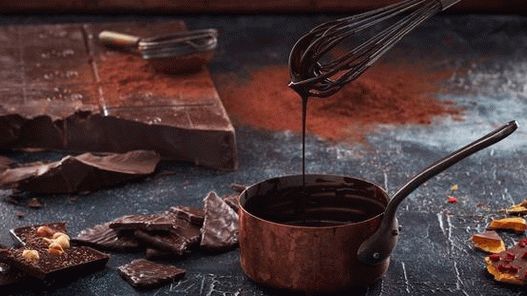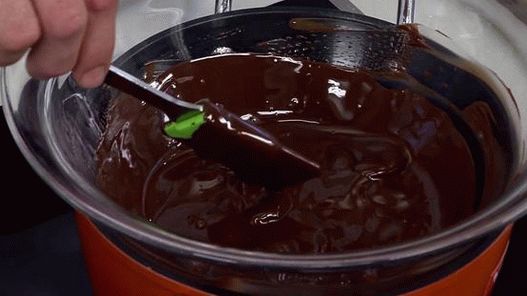Tempered chocolate is the secret of a professional look chocolates. Chocolate does not melt, has a smooth surface, it the texture must be recrystallized to acquire these properties. Tempered chocolate crunches nicely when tested for quality. If chocolate is simply melted without hardening, as a rule, it becomes soft or viscous, and it may also be gray or white stripes and spots. It is impossible to dip products into them; they just pick up a lumpy lump on themselves and flow when room temperature. Tempering helps to avoid these common problems and get beautiful chocolates like from the factory conveyor.
The author of the recipe is Elizabeth Labau, a culinary writer, pastry chef, food photographer from Salt Lake City, Utah, USA
 Time: 1 hour.
Time: 1 hour.
Recipe:
Do I need to temper chocolate?
If you want to make sweets that are smooth and shiny on the outside, but not ready to spend time on tempering, there are two options. Can use ready-made icing (a product called Candy Melts) instead of regular melted chocolate, it will also preserve properties at room temperature. If you decide to melt regular chocolate, then the candies coated with it should be kept in refrigerator and get out just before serving so that they don’t faded. You will need:
- 450 g minimum of chocolate
- Chocolate thermometer
- Microwave
- Glass bowl suitable for microwave
- Rubber paddle
- Choose chocolate, bitter, milk and white chocolate, tempering temperature for each is different. It is best to take a mass of 450 g., Since a large amount of chocolate retains the necessary texture longer, and it does not crack. If a it is more than you need, you can always leave surplus for future use. Dark chocolate is easiest to temper (70% cocoa), so if this is your first time doing it, I recommend take just such, not diluted with milk powder. When you train, you can experiment with milk or white with chocolate. Make sure your chocolate has a good texture. that is, it is shiny and hard. If it has white or gray layers, or it crumbles, then such a chocolate is not the best choice for this method of hardening. Also do not use chocolate chips, tempering is much more difficult.
- Chop the chocolate. About a quarter of the chocolate side. Cut the remaining 3/4 into small pieces and place in a bowl suitable for a microwave.
- Melt the chocolate. Heat a bowl of chocolate pieces in the microwave at intervals of 30 seconds. After each call mix. Heat and stir until melted chocolate completely does not melt with its heat the remaining thawed pieces and the chocolate mass will not be uniform.
Bring dark chocolate to 46 ° C, milk or white – up to 43 ° С. When the chocolate melts, check the temperature using a thermometer. If it is below 46 ° C, heat the chocolate short intervals until this temperature is reached, but watch him closely. Do not let it heat up more than you need it, otherwise it can become tight, intractable, or even burn out. Add the remaining portion of chocolate to the bowl and gently stir to combine with the total mass, so the temperature will fall. Stir almost constantly, melting a piece chocolate. I use scratching movements to tuck this piece into the melted mass. Warm chocolate will melt that portion which you added, and it in turn contributes to cooling melted chocolate. Cool dark chocolate to 32 ° C, milk or white – up to 30 ° C. Keep stirring the chocolate until it cools to the specified temperature. Check density chocolate. Spat some chocolate on a piece with a spatula parchment or wax paper and see if it hardens. Well-tempered chocolate will begin to solidify within a few minutes. You will see that at first it will lose its luster and become more matte, then it will solidify around the edges. In a cool room a layer of hardened chocolate should solidify for 4-6 minutes. If he doesn’t look hardened, keep stirring and cooling the chocolate another 1-2 degrees, and then check it again. Different chocolate manufacturers as well as different environmental conditions sometimes require other temperatures for tempering. Remove possible pieces in melted chocolate. If a piece of chocolate is not completely melted, remove it from the melted mass to it did not contribute to cooling too quickly. Your chocolate tempered and ready! Now proceed directly to making sweets. You can cover finished chilled products tempered chocolate, for this it needs to be melted to working temperature. And dip sweets or truffles to give shine. tip for use  For work with tempered chocolate you will need to melt it in microwave or in a water bath, it should be warm, but not hot. Operating temperature, ideally 29-31 ° C for dark chocolate and 30 ° C for milk or white, allow you to comfortably envelop products. It can be kept over the pan with warm (but not boiling) water, stirring occasionally, or try put on a warm electric mat, setting low temperature and putting a towel between a heating pad and a bowl. Whatever the method you choose, it is important to monitor the temperature and often stir the chocolate so that the whole mass is kept the same temperature. Recipes with similar ingredients: Chocolate
For work with tempered chocolate you will need to melt it in microwave or in a water bath, it should be warm, but not hot. Operating temperature, ideally 29-31 ° C for dark chocolate and 30 ° C for milk or white, allow you to comfortably envelop products. It can be kept over the pan with warm (but not boiling) water, stirring occasionally, or try put on a warm electric mat, setting low temperature and putting a towel between a heating pad and a bowl. Whatever the method you choose, it is important to monitor the temperature and often stir the chocolate so that the whole mass is kept the same temperature. Recipes with similar ingredients: Chocolate








